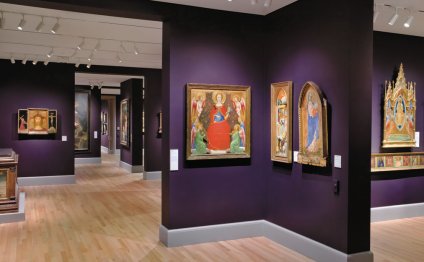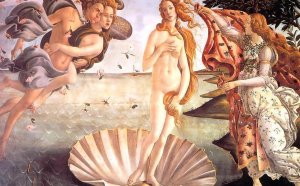
Early Italian Art
 Typical Byzantine Mosaic
Typical Byzantine Mosaic
8th century.(w)
We tend to assume that every age must be greater than the one that it preceded, but this is not always the case. The Roman Empire was the centre of world civilization until its demise in 476. Europe had entered the Middle Ages or lasting for a thousand years.
The lessons of classical antiquity, Greek and Roman sculpture, architecture and literature did not surface again until the start of the Renaissance in Italy. The beginnings of the Italian Renaissance centred on Tuscany and on Florence in particular. The Italians of the period considered themselves to be living in a golden age, superior to anything since the fall of the roman empire a thousand years earlier, with painting, sculpture, music, poetry and architecture all awakening to a revival after sleeping for centuries.
Italian Renaissance Art began with (c. 1267-1337) who is considered to be the first painter to have broken with the tradition of Byzantine art at the end of the middle ages. Giotto made advances in representing the human body in a more realistic way, and his technique was the first to realize this change since the times of classical antiquity.
Renaissance Influences and events.
Florence was a major financial centre and, for around sixty years, was dominated by the Medici family. The Medici became patrons of art and lie at the heart of the early Renaissance. The family was one of the wealthiest in Europe, and were among the most important patrons of the arts in Renaissance Italy. Go to the page to see just how important their patronage was.
Deposition. Giotto. (w)
The Scrovegni Chapel Padua, Veneto, Italy.
It is largely due to the Italian painter and architect Giorgio Vasari that we have such a wealth of information about the artists of the Italian Renaissance. His biographies have given us a valuable insight into the lives of the painters of the period and his influence cannot be overlooked. Go to page to learn more about his work.
The Plague.
The Black Death of 1348 swept across Europe and it has been estimated that one third of the population died as a result of this pandemic. This decline in population continued and in 1450 the population of Europe was around half of what it had been in the early part of the fourteenth century. This almost unique slump in population resulted in major cultural changes, land became more abundant and labour became scarcer. This led to a society dependant on trade and industrial enterprise rather than on a land and rent based system.
The result was that the innovation started by Giotto was not taken up again until much later by such artists as, , and
Arts.
Almost all of the art of the period has a religious theme with scenes from the bible taking prominence.
Brunelleschi was responsible for the emergence of both renaissance architecture and perspective drawing, his work had a profound influence on the sculptors and painters of the day. Donatello, along with his contemporary Ghiberti, was the greatest sculptor of the fifteenth century, he produced a range of astonishing work over a sixty-year period. Masaccio was the most accomplished painter of the early fifteenth century. His paintings incorporate the lessons learned from his personal connections with Brunelleschi and Donatello.
YOU MIGHT ALSO LIKE


Share this Post
Related posts
15th century Italian Art
At the end of the Middle Ages, art across Europe was dominated by a decorative and refined manner known as the International…
Read MoreItalian Art Paintings
ROME Amid recriminations and wildly diverging theories, Italian politicians and art critics are still trying to comprehend…
Read More





